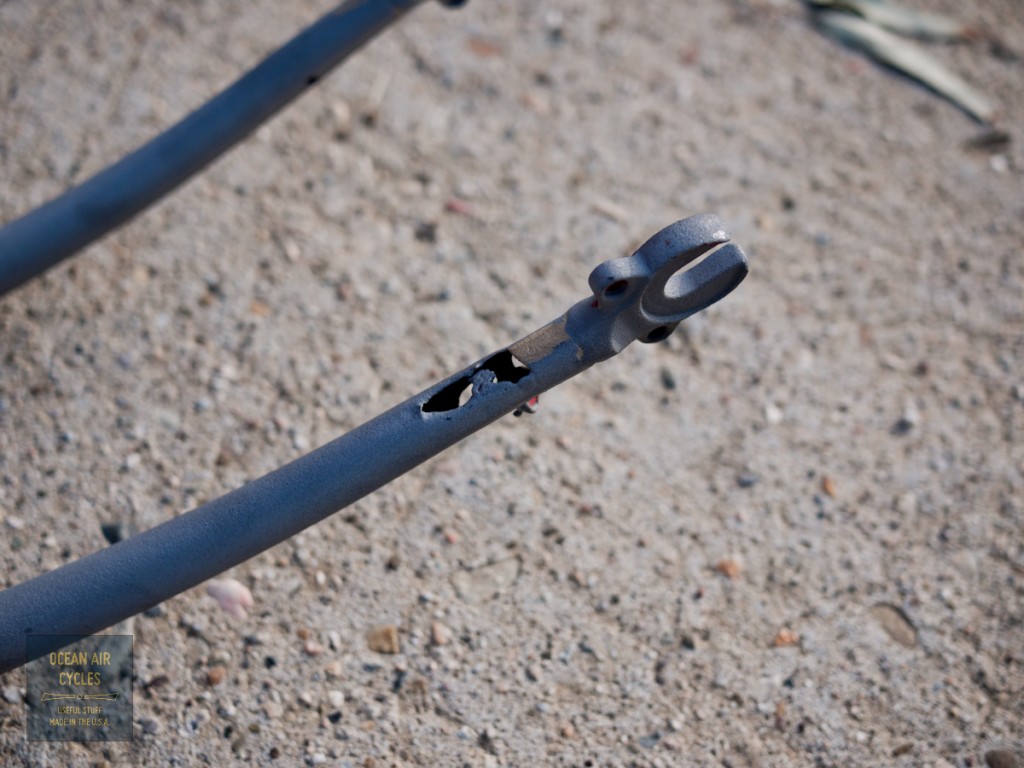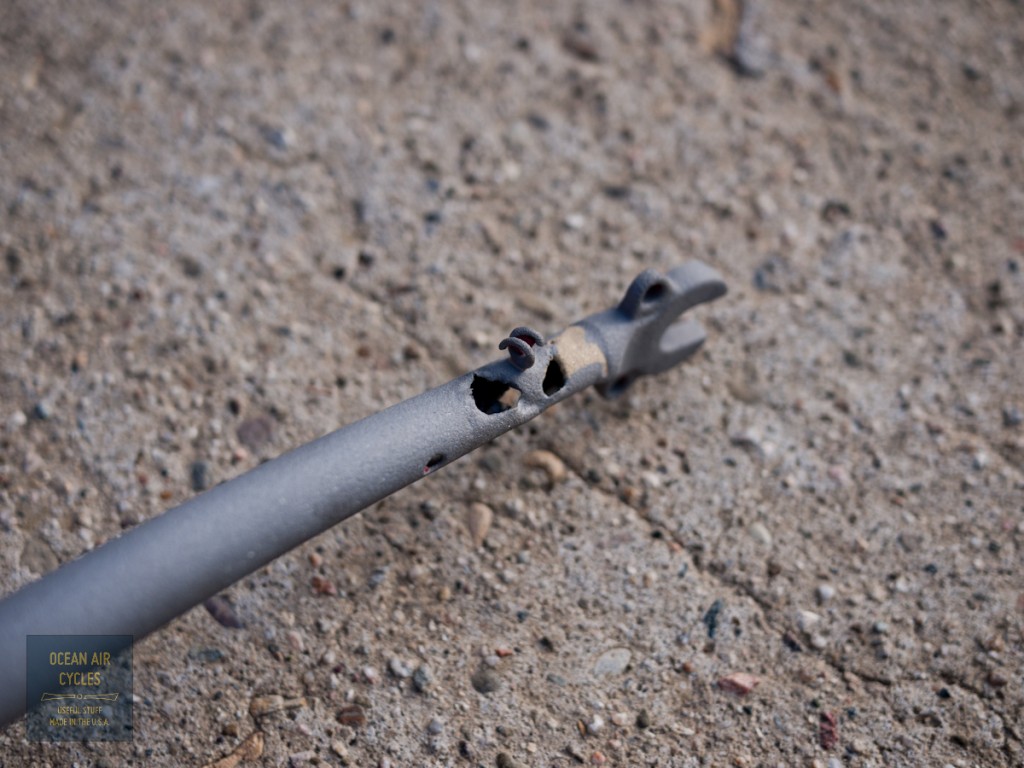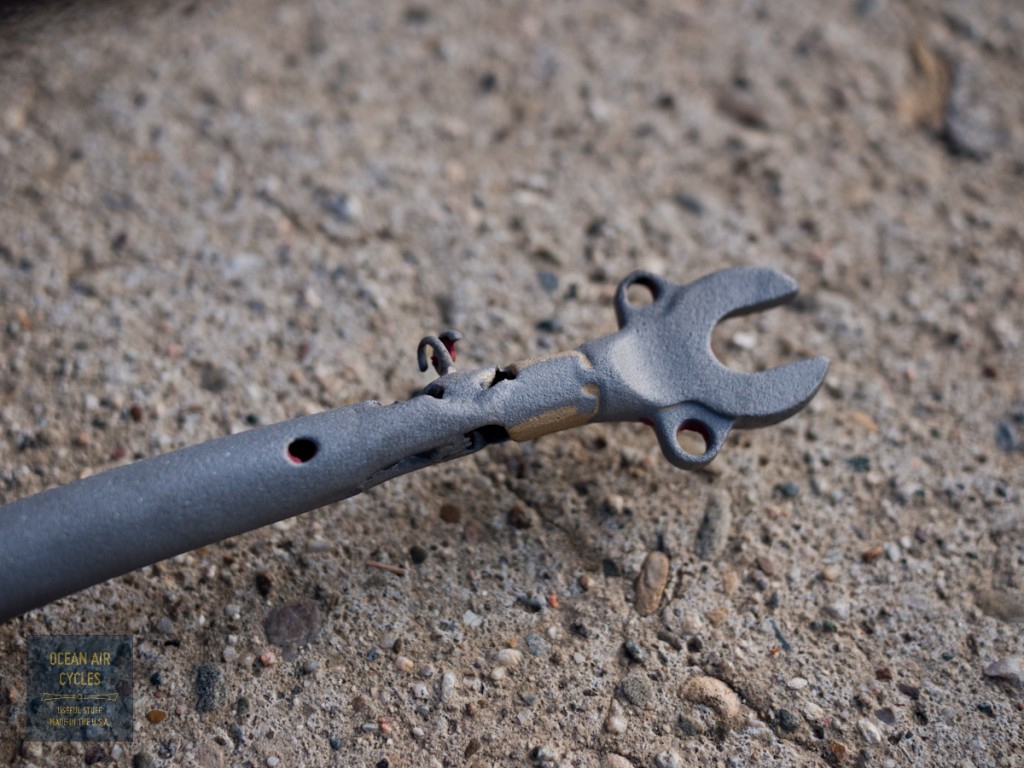I am one of those sorts of people who learns by doing. Sometimes by book or example first, but usually but jumping in and doing it. Todays lesson? Never audition a new coater on bike or part that you need, particularly soon. The call came last evening, the blaster had shot a hole in the fork ?!?!? The fork was in for a chemical strip, light blast only if touch-up was needed and then a new single coat of red. The goal being a complete red 57cm Rambler for the SF Expo. The first attempt at red had gone on too thick and yellow, and it was in for a re-do with a local. He was not happy with how thick it came out and was going to do it a third time. I figured the fork would be a good audition for having a local option to do custom color requests.
I went by the shop this morning to see the “hole”:
I am still not really sure how a blaster could do this exactly. Obviously this fork will be retired. We are currently working on a resolution, and I am sure between the blaster and the coater this will be made right.
With the cup being half full, I am in shock and awe that the wire guides are intact. Also, it is clear that my guys in Portland are getting good brass penetration into the dropouts. And last but not least, one less bike to transport to SF.
Trick or Treat? I am hoping for the treats, this was not how I planned for the day to start.



I bet they used sand or grit rather than bead?
As the details are coming to light I would not be surprised to find out it was something like Black Beauty through a 3 inch hose from a few feet back. Everything that could be wrong sort of happened, even though it was not supposed to. Never a dull moment.
Uggg! It’s a scary thing taking your bike to someone to strip off the existing paint/coat. Hope they make you well.
Mike
I am sure you can relate to this having had a foot on each side of the engineering spectrum, your old job and your own bike projects. With the bikes there is an apparent resistance to long spec and drawing requirements and binding contracts, etc. it is mostly a PO and or a handshake to get work rolling. Coming from a strong engineering background my gut feeling it to have a written spec, drawing with summary notes etc. but the contractors look at it and gloss over in my experience so far. This guy has the skills to do everything from body panels to frame members and some fine art stuff, we talked in depth about the requirements and this still happened, “the masking tape just comes off sometimes” and the brake bosses crown race etc are all shot. I am not even going to be using this to prop up a bike at the expo. It really is a buzz kill as this was going to be the show piece, size medium for test rides, dynamo lights the works. I am hoping typing it out helps me let go and move on to other must do tasks. I am so bummed.
I am hoping that he has a change of mind over night and realizes this is pure negligence on his part, he claimed the knowledge and skills to do this correctly, and makes it right, he tried to pass it off on the blaster he sent it too, but it never should have been sent to a pipeline blaster to begin with. Now that it is back on his shoulders there has only been an offer of free future work, which does not really help me get a fork back on the bike.
I am disappointed with myself for letting something of value out of may hands without everything crystal clear in writing, but I can run up a long list of people I would let do this without a written spec as well, this guy was just local. It will not happen a second time. Lesson learned and tome to re-focus on the things that I can fix.
Look where the drain hole is and where most of your damage is. It leads one to think the fork wasn’t properly rinsed after the “chemical dip.” IMHO, the chemical dip was a waste of time, if the paint was too “thick,” then why not have wet sanded it instead of doing the whole process over? Looking at the roughness on the metal, I would also humbly guess the blaster used sand, not beads, or better, walnut shell. Your painter is also probably unaware of how thin the tubing was in the first place.
IMHO, frame builders give a lot of their profit to their painters. The beauty of painting is that one doesn’t need super expensive equipment to get a beautiful result. You’d be amazed what even a can of Rustoleum can do in the right hands. Forget the Imron, try the single-stage solid color Centari enamel. You can wet sand it, still add a clear coat and not kill yourself in the process. Nor have to waste the excess. It seems if you can braze, you could get a good handle on painting. Try with the laquer spraybombs sold in the auto paint stores before investing in a compressor and gun! : )
With some more prodding of the coater it is looking like there never was a chemical strip. The for was sent to a blaster that uses fresh garnet through a fire hose on pipelines. I am suspecting the combination of thicker coating on the lower portion of the fork and heat from the blasting helped, but it really boils down to blaster negligence. Really, why did they not stop once the holes started? There are other thin spots on the blade, these are just the ones that went through. We talked at length about the thinness of the blades, and the need to not blast with sand. Lots of head shaking and a firm handshake that he would take care of it. Everything in writing from now on, no more handshake deals, ever.
I will look into some of the other liquid color options. So far all of the professional wet coat quotes I have gotten come in 4 to 5 times the cost of PC, and that is all of my profit, not just most.